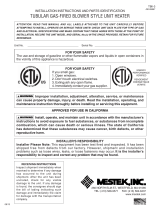
5
UEZ-IOM (01-24) 1034347-J
Certification
• These unit heaters are listed by Intertek for use in industrial and commercial installations in the United States
and Canada. In addition, unit sizes 55, 85, and 110 are listed in the United States and Canada as utility heaters
for use in non-living spaces that are attached to, adjacent to, or part of a structure that contains space for family
living quarters.
• These unit heaters are available for use with either natural or propane gas. The type of gas, the input rate, and
the electrical supply requirement are shown on the heater rating plate. Check the rating plate to determine if the
heater is appropriate for the intended installation. All heaters are factory-equipped for use with natural gas and
include a conversion kit for field-conversion for use with propane.
• These unit heaters have a titanium stabilized primary heat exchanger with a MacroChannel® secondary heat
exchanger.
Warranty
Refer to the limited warranty form in the literature bag provided with the unit. The warranty is void if:
• Wiring is not in accordance with the diagram furnished with the heater.
• The unit is installed without proper clearance to combustible materials.
• A fan model is connected to a duct system or if the air delivery system is modified.
Installation Codes
• These units must be installed in accordance with local building codes. In the absence of local codes, in the United
States, the unit must be installed in accordance with the National Fuel Gas Code (ANSI Z223.1, latest edition). A
Canadian installation must be in accordance with the Natural Gas and Propane Installation Code (CSA B149, latest
edition). This code is available from CSA Information Services, 1-800-463-6727. Local authorities having jurisdiction
should be consulted before installation is made to verify local codes and installation procedure requirements.
• Installations in aircraft hangars should be in accordance with the Standard for Aircraft Hangars (ANSI/NFPA No.
409, latest edition). Installations in public garages should be in accordance with the Standard for Parking Structures
(ANSI/NFPA No. 88A, latest edition). Installations in repair garages should be in accordance with the Standard
for Repair Garages (ANSI/NFPA No. 88B, latest edition). In Canada, installations in aircraft hangars should be
in accordance with the requirements of the enforcing authorities, and in public garages, in accordance with the
CSA B149 code.
• If the heater is being installed in the Commonwealth of Massachusetts, installation must be performed by a licensed
plumber or licensed gas fitter.
Heater Location
⚠ CAUTION ⚠
• Unit heaters should not be used in an application where the heated space temperature is below 40°F
(4°C). The combination of low space and combustion air temperatures may result in condensate
freezing in the secondary heat exchanger and/or condensate drain.
• Do not locate the heater where it may be exposed to water spray, rain, or dripping water.
For best results, the heater should be mounted with certain rules in mind:
• Units should always be arranged to blow toward or along exposed wall surfaces, if possible. Where two or more
units are installed in the same room, a general scheme of air circulation should be maintained for best results.
• Suspended heaters are most effective when located as close to the working zone as possible, and this fact should
be kept in mind when determining the mounting heights to be used. However, care should be exercised to avoid
directing the discharged air directly on the room occupants.
• Partitions, columns, counters, or other obstructions should be taken into consideration when locating the unit heater
so that a minimum quantity of airflow will be deflected by such obstacles.
• When units are located in the center of the space to be heated, the air should be discharged toward the exposed
walls. In large areas, units should be located to discharge air along exposed walls with extra units provided to
discharge air in toward the center of the area.





















